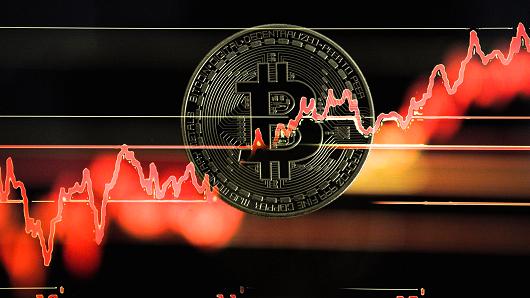Highly volatile digital currency becomes ‘a sign of speculative enthusiasm’ for some
Investors are latching onto bitcoin as a new indicator for determining whether the stock market is headed for another downturn.
A number of traders said they started paying closer attention to the highly volatile digital currency after it suffered a sharp fall about a month before the global stock market decline. The price of a bitcoin roughly halved from its late-December high of near $20,000, reversing a powerful speculative rally. That was followed by the first 10% decline in the S&P 500 in two years, beginning in late January. Recently, both have been volatile.
Some investors say the tandem moves suggest bitcoin may be a barometer of investor sentiment that ultimately feeds into the stock market and other risky investments. If stocks are headed for another pullback, the thinking goes, bitcoin may fall first—and harder.
“We’ve begun to watch bitcoin more closely as a sign of speculative enthusiasm,” said Doug Ramsey, chief investment officer of the Minneapolis money manager Leuthold Group. The top in bitcoin in December and stocks in January marked a peak in investor optimism, Mr. Ramsey said.
Tom Forester, chief investment officer at Forester Capital Management, said he pays particular attention to the big moves in the cryptocurrency when looking for signals. “We do view bitcoin as a sentiment indicator,” he said.
In recent days, stocks and bitcoin have both been volatile, but for different reasons. Equities fell as the U.S. discussed and signed tariffs on steel and aluminum, then rebounded after a strong jobs report on Friday. Bitcoin prices dropped below $10,000 apiece recently as regulators globally scrutinized cryptocurrencies.
Still, the relationship has been most closely aligned when investor sentiment is driving financial markets. Last month as the stock market sold off, the correlation between the cryptocurrency and the S&P 500 jumped to its highest in records going back to the beginning of 2016, according DataTrek Research, which looked at that link on a 90-day basis. Shorter-term correlations spiked as well, the firm found.
For some investors, bitcoin is fulfilling a role that other highly volatile investments have played during previous market run-ups when frothy levels had become a concern: The highest-returning asset is often among the first to fall when investor appetite for risk starts to change.
During the 1990s dot-com boom, for example, some of the most speculative companies with little or no profit history, from e-commerce retailer Pets.com Inc. to online grocery business Webvan Group Inc., shot to prominence the fastest. They were also among the hardest to fall, signaling a broader market retreat when the S&P 500 dropped 49% from its peak in 2000 to its trough in the fall of 2002.
With the U.S. stock market bull run reaching its nine-year anniversary on Friday, investors are worried that the Federal Reserve is starting to pull back its extraordinary easing measure at a time when valuations are becoming stretched and the long U.S. economic expansion appears to be in its later stages. The proposed steel and aluminum tariffs have ignited concerns of a trade war. All this has traders looking for fresh signs that investor sentiment is turning again.
Since many of the more speculative assets have been rising alongside stocks, any investor retreat from risk could have broad ramifications in markets ranging from metals and oil to emerging-market bonds.
Few rallies have approached the size of bitcoin’s, where prices ran up from less than $1,000 at the beginning of 2017 to about 20 times that level in under 12 months. That drew in mainstream investor interest and spawned a series of other digital currencies. In one sign of crypto fever, an ice tea company rebranded to focus on the technology used in bitcoin.
The S&P 500’s forward price-to-earnings ratio, a traditional valuation measure, topped out on the same December day that the bitcoin price peaked, according to Morgan Stanley . That was shortly before Congress passed a sweeping tax code overhaul, and the two gauges acted as a sign of “peak excitement” in the market, the bank’s analysts concluded.
The virtual currency bitcoin continues surging to new highs as a frenzy of investors get in on the action. WSJ’s Paul Vigna explains what you need to know, and how to invest should you want to join the mania. Photo: Alexander Hotz/The Wall Street Journal.
Many analysts say there are limits to the link between bitcoin and stocks. Nicholas Colas, co-founder of DataTrek, found that the high correlations began to drop after the market selloff ebbed in the middle of last month. Mr. Colas concluded that while there are signs the correlations between the two assets have been rising in recent months, the link is strongest when the assets are falling.
Others outright reject bitcoin’s value as a stock market indicator. “I think that’s absurd,” said Jason Ware, chief investment officer at Albion Financial Group. “Ultimately, stock returns are grounded in the economy, corporate earnings, interest rates and inflation,” which he said that bitcoin investors don’t seem to care much about.
Movements in the two assets have some very different characteristics. The levels of the S&P 500 and bitcoin have moved in the same direction on just over half of weekday trading sessions since the end of October, according to The Wall Street Journal’s Market Data Group. That is hardly a lockstep relationship.
But even those who aren’t convinced bitcoin will signal the next big fall in stock prices say they are watching the cryptocurrency alongside other sentiment gauges.
“I feel that there is always something at a top that offers a clue,” said Bruce Bittles, chief investment strategist at Baird.
Read more at:
www.wsj.com
x







